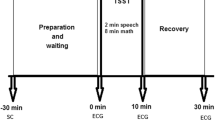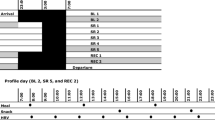Abstract
This study examined the relation of self-reported stress to cardiac autonomic modulation in real-life conditions. The participants for the study were healthy male (N = 59) and female (N = 40) employees (age 40 ± 10 years). A single-item question and a 14-item questionnaire on perceived stress were administered to the participants before the experimental night. RR-intervals (RRI) were recorded during night sleep and an orthostatic test after awakening at home. The RRI data were analyzed for heart rate (HR) and heart rate variability (HRV) in time and frequency domains. Nocturnal urinary stress hormone (cortisol, adrenal and noradrenal) secretion was also analyzed. Based on the self-reported stress, the participants were divided into either low or high stress group. The results showed that higher incidence of stress symptoms was significantly associated with lower HRV in the orthostatic test regardless of age and gender. Differences between the stress groups in HRV indices were approximately 20–50 and 30–75% in supine and standing positions, respectively. No difference was found in nocturnal HR, HRV, or stress hormone secretion between the stress groups. Higher incidence of stress symptoms was significantly associated with greater decrease of HRV from night sleep to the orthostatic test, as a response to awakening. In conclusion, the present findings support the view that autonomic modulation measured in the orthostatic test, but not during night sleep, is related to self-reported stress.

Similar content being viewed by others
References
Ahola K, Honkonen T, Kivimaki M et al (2006) Contribution of burnout to the association between job strain and depression: the health 2000 study. J Occup Environ Med 48:1023–1030. doi:10.1097/01.jom.0000237437.84513.92
Akselrod S, Gordon D, Ubel FA, Shannon DC, Berger AC, Cohen RJ (1981) Power spectrum analysis of heart rate fluctuation: a quantitative probe of beat-to-beat cardiovascular control. Science 213:220–222
Barantke M, Krauss T, Ortak J et al (2008) Effects of gender and aging on differential autonomic responses to orthostatic maneuvers. J Cardiovasc Electrophysiol 19:1296–1303. doi:10.1111/j.1540-8167.2008.01257.x
Bigger JT Jr, Fleiss JL, Steinman RC, Rolnitzky LM, Kleiger RE, Rottman JN (1992) Frequency domain measures of heart period variability and mortality after myocardial infarction. Circulation 85:164–171
Brosschot JF, Van Dijk E, Thayer JF (2007) Daily worry is related to low heart rate variability during waking and the subsequent nocturnal sleep period. Int J Psychophysiol 63:39–47. doi:10.1016/j.ijpsycho.2006.07.016
Chida Y, Steptoe A (2009) Cortisol awakening response and psychosocial factors: a systematic review and meta-analysis. Biol Psychol 80:265–278. doi:10.1016/j.biopsycho.2008.10.004
Cohen S, Kamarck T, Mermelstein R (1983) A global measure of perceived stress. J Health Soc Behav 24:385–396
De Meersman RE (1993) Heart rate variability and aerobic fitness. Am Heart J 125:726–731
Dishman RK, Nakamura Y, Garcia ME, Thompson RW, Dunn AL, Blair SN (2000) Heart rate variability, trait anxiety, and perceived stress among physically fit men and women. Int J Psychophysiol 37:121–133
Dodt C, Breckling U, Derad I, Fehm HL, Born J (1997) Plasma epinephrine and norepinephrine concentrations of healthy humans associated with nighttime sleep and morning arousal. Hypertension 30:71–76
Elo AL, Leppanen A, Lindström K (1992) Occupational stress questionnaire: user’s instructions. Institute of Occupational Health, Helsinki
Elo AL, Leppanen A, Jahkola A (2003) Validity of a single-item measure of stress symptoms. Scand J Work Environ Health 29:444–451
Hohnloser SH, Klingenheben T (1998) Basic autonomic tests. In: Malik M (ed) Clinical guide to cardiac autonomic tests. Kluwer, Dordrecht
Huikuri HV, Kessler KM, Terracall E, Castellanos A, Linnaluoto MK, Myerburg RJ (1990) Reproducibility and circadian rhythm of heart rate variability in healthy subjects. Am J Cardiol 65:391–393
Huikuri HV, Makikallio TH, Airaksinen KE et al (1998) Power–law relationship of heart rate variability as a predictor of mortality in the elderly. Circulation 97:2031–2036
Hynynen E, Uusitalo A, Konttinen N, Rusko H (2006) Heart rate variability during night sleep and after awakening in overtrained athletes. Med Sci Sports Exerc 38:313–317. doi:10.1249/01.mss.0000184631.27641.b5
Hynynen E, Nummela A, Rusko H, Hamalainen I, Jylhä R (2007) Effects of training on cardiac autonomic modulation during night sleep in cross country skiers. In: Linnamo V, Komi PV, Müller E (eds) Science in Nordic skiing. Meyer & Meyer Sport Ltd., UK
Hynynen E, Uusitalo A, Konttinen N, Rusko H (2008) Cardiac autonomic responses to standing up and cognitive task in overtrained athletes. Int J Sports Med 29:552–558. doi:10.1055/s-2007-989286
Hynynen E, Konttinen N, Rusko H (2009) Heart rate variability and stress hormones in novice and experienced parachutists anticipating a jump. Aviat Space Environ Med 80:976–980
Kivimaki M, Virtanen M, Elovainio M, Kouvonen A, Vaananen A, Vahtera J (2006) Work stress in the etiology of coronary heart disease—a meta-analysis. Scand J Work Environ Health 32:431–442
Lehmann M, Schnee W, Scheu R, Stockhausen W, Bachl N (1992) Decreased nocturnal catecholamine excretion: parameter for an overtraining syndrome in athletes? Int J Sports Med 13:236–242
Loimaala A, Sievanen H, Laukkanen R, Parkka J, Vuori I, Huikuri H (1999) Accuracy of a novel real-time microprocessor QRS detector for heart rate variability assessment. Clin Physiol 19:84–88
Lombardi F (2002) Clinical implications of present physiological understanding of HRV components. Card Electrophysiol Rev 6:245–249
Lucini D, Norbiato G, Clerici M, Pagani M (2002) Hemodynamic and autonomic adjustments to real life stress conditions in humans. Hypertension 39:184–188
Lucini D, Riva S, Pizzinelli P, Pagani M (2007) Stress management at the worksite: reversal of symptoms profile and cardiovascular dysregulation. Hypertension 49:291–297. doi:10.1161/01.HYP.0000255034.42285.58
Maina G, Bovenzi M, Palmas A, Larese Filon F (2009) Associations between two job stress models and measures of salivary cortisol. Int Arch Occup Environ Health. doi:10.1007/s00420-009-0439-0
Martinmaki K, Rusko H, Kooistra L, Kettunen J, Saalasti S (2006) Intraindividual validation of heart rate variability indexes to measure vagal effects on hearts. Am J Physiol Heart Circ Physiol 290:H640–H647. doi:10.1152/ajpheart.00054.2005
Melamed S, Shirom A, Toker S, Berliner S, Shapira I (2006) Burnout and risk of cardiovascular disease: evidence, possible causal paths, and promising research directions. Psychol Bull 132:327–353. doi:10.1037/0033-2909.132.3.327
Mourot L, Bouhaddi M, Perrey S et al (2004) Decrease in heart rate variability with overtraining: assessment by the Poincare plot analysis. Clin Physiol Funct Imaging 24:10–18
O’Connor DB, Hendrickx H, Dadd T et al (2009) Cortisol awakening rise in middle-aged women in relation to psychological stress. Psychoneuroendocrinology 34:1486–1494. doi:10.1016/j.psyneuen.2009.05.002
Pichot V, Roche F, Gaspoz JM et al (2000) Relation between heart rate variability and training load in middle-distance runners. Med Sci Sports Exerc 32:1729–1736
Pichot V, Bourin E, Roche F et al (2002) Quantification of cumulated physical fatigue at the workplace. Pflugers Arch 445:267–272. doi:10.1007/s00424-002-0917-7
Pieper S, Brosschot JF (2005) Prolonged stress-related cardiovascular activation: Is there any? Ann Behav Med 30:91–103. doi:10.1207/s15324796abm3002_1
Porges SW (1992) Vagal tone: a physiologic marker of stress vulnerability. Pediatrics 90:498–504
Rosengren A, Hawken S, Ounpuu S et al (2004) Association of psychosocial risk factors with risk of acute myocardial infarction in 11119 cases and 13648 controls from 52 countries (the INTERHEART study): case–control study. Lancet 364:953–962. doi:10.1016/S0140-6736(04)17019-0
Ruha A, Sallinen S, Nissila S (1997) A real-time microprocessor QRS detector system with a 1-ms timing accuracy for the measurement of ambulatory HRV. IEEE Trans Biomed Eng 44:159–167. doi:10.1109/10.554762
Siegrist J (1996) Adverse health effects of high-effort/low-reward conditions. J Occup Health Psychol 1:27–41
Task Force (1996) Heart rate variability: standards of measurement, physiological interpretation and clinical use.Task Force of the European Society of Cardiology and the North American Society of Pacing and Electrophysiology. Circulation 93:1043–1065
Taylor JA, Carr DL, Myers CW, Eckberg DL (1998) Mechanisms underlying very-low-frequency RR-interval oscillations in humans. Circulation 98:547–555
Tsuji H, Larson MG, Venditti FJ Jr et al (1996) Impact of reduced heart rate variability on risk for cardiac events. The Framingham Heart Study. Circulation 94:2850–2855
Vanoli E, Adamson PB, Ba-Lin PinnaGD, Lazzara R, Orr WC (1995) Heart rate variability during specific sleep stages. A comparison of healthy subjects with patients after myocardial infarction. Circulation 91:1918–1922
Vreeburg SA, Zitman FG, van Pelt J et al (2010) Salivary cortisol levels in persons with and without different anxiety disorders. Psychosom Med 72:340–347. doi:10.1097/PSY.0b013e3181d2f0c8
Vrijkotte TG, van Doornen LJ, de Geus EJ (2000) Effects of work stress on ambulatory blood pressure, heart rate, and heart rate variability. Hypertension 35:880–886
Acknowledgments
This study was funded by grants from TEKES-National Technology Agency of Finland, Juho Vainio Foundation, Finland and Foundation of Sports Institute, Finland. The authors declare that the experiments comply with the current laws of Finland.
Conflict of interest
The authors declare that they have no conflict of interest.
Author information
Authors and Affiliations
Corresponding author
Additional information
Communicated by Dag Linnarsson.
Rights and permissions
About this article
Cite this article
Hynynen, E., Konttinen, N., Kinnunen, U. et al. The incidence of stress symptoms and heart rate variability during sleep and orthostatic test. Eur J Appl Physiol 111, 733–741 (2011). https://doi.org/10.1007/s00421-010-1698-x
Accepted:
Published:
Issue Date:
DOI: https://doi.org/10.1007/s00421-010-1698-x




